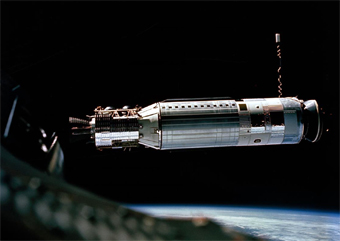
Agena target vehicle March 16, 1966/
photo by David Scott/NASA
Fifty Years Ago in Space:
Gemini’s First Docking
| published March 16, 2016 |
By Keith H. Roberts, Thursday Review contributor
More than half of all American now alive were not even born yet, but those of the Baby Boom years, it was an important mile marker along the road to space travel and deep space exploration.
On March 16, 1966—fifty years ago today—the crew of Gemini 8 successfully docked the two-person spaceship with the Agena target vehicle. The rendezvous and docking maneuver was an essential step in a complex series of steps necessary to eventually enable NASA astronauts to reach the moon. Engineers and scientists had already concluded that any moon mission would require at least one, if not more than one, set of spacecraft docking programs, which meant that it would be necessary for astronauts and computers to be able to locate another object already in orbit. Rendezvous and docking would be essential in Earth orbit, but even more of a requirement in Lunar orbit, when a crew on the surface of the moon would have to blast off and then relocate the vehicle which would take the full crew back home.
In short: no rendezvous and docking, no moon landing.
This photo, taken by astronaut David Scott, shows the Agena vehicle approximately 45 feet from the approaching Gemini spacecraft, which was being piloted by Neil Armstrong. The docking went smoothly, but unforeseen problems with the immediate aftermath—in which the fully linked vehicles began to go into a series of rolls and pitches—required patience and skill on the part of Armstrong and Scott. Unable to regain control of the now-coupled spacecrafts after 30 minutes, Armstrong and Scott eventually had to disengage, allowing the Agena to spin off and away from the Gemini capsule. Armstrong and Scott then used the Gemini’s re-entry control system to regain control of the Gemini capsule, which was pitching, spinning and tumbling at a dangerous rate.
The tumbling, which Scott described as end-over-end, was reaching such a critical speed that blurred vision and vertigo was beginning to impact the astronauts’ ability to function. Worse, the crew had just passed from within tracking range of ground controllers. NASA was unable to send up computer instructions to the Agena or to Gemini. Quick thinking by Armstrong surely saved their lives, as the spin rate and tumble rate—had it accelerated even by the tiniest fraction of a second—would have caused the mission to end in disaster.
That near mishap proved to be a valuable lesson for NASA engineers and astronauts, and offered vindication for giving redundant control to both astronauts and computers. But more importantly, the success of that first rendezvous and docking paved the way for hundreds of missions over the years, and allowed NASA and ESA (European Space Agency) astronauts to develop skills used even now with the routine rendezvous processes required to reach the International Space Station.
Related Thursday Review articles:
A Shuttle Mission: 21 years Ago; Thursday Review staff; Thursday Review; February 3, 2016.
Gemini's 50th Anniversary; Thursday Review staff; Thursday Review; March 23, 2015.
